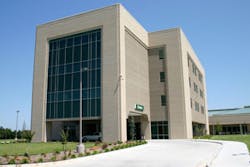Muskogee Community Hospital in Muskogee, Okla., is accustomed to achieving firsts. It was the first hospital in the country, for example, designed to meet the Environmental Protection Agency's (EPA) Energy Star criteria. It was also at the first to receive Gold LEED (Leadership in Energy and Environmental Design) certification from the U.S. Green Building Council. The hospital's environmental commitment includes using a geothermal system to heat and cool the buildings and planting trees to provide shade in summer to keep temperatures down.
The hospital further demonstrated its environmental credentials in its data center by finding a way to double up key technology elements to lower costs, cut energy consumption and at the same time, increase efficiency. This was accomplished with the help of a CloudBank storage array from Pivot3. Initially purchased to store video from the security cameras, the hospital also uses the array to backup its Exchange and file servers, and as a host for one of its clinical imaging systems.
"The cost of ownership is much lower with the Pivot3 array doing double duty for video surveillance and IT systems," says Owetha Wilson, the hospital's IT administrator. "Instead of having to buy another hardware setup, all we had to pay for is the licensing for the server."
Savings from the Start
The savings from the video surveillance system started before the hospital opened for business. As is typical for major building projects, the hospital owners planned to lease security cameras to safeguard the site during construction. Rather than paying the typical $3,000 per month to rent equipment, though, the hospital followed the advice of its integrator partner Digi Surveillance Systems, and purchased higher quality cameras for construction monitoring and then incorporated that equipment into the hospital's security system. By purchasing the equipment outright, the hospital got superior coverage during construction and took $30,000 off the final bill for the video surveillance system.
The surveillance system uses a mix of digital and analog cameras, including Avigilon high-definition cameras (2- to 5-megapixel) with remote pan/tilt/zoom (PTZ) controls. During construction, the cameras were placed on poles around the 22-acre site and on the construction trailer. The cameras are managed using Avigilon Control Center network video management software with connections to the architects' office and the construction company's headquarters so they could monitor progress, and the sheriff's office for security. The hospital's owner and managers could also remotely view the cameras.
Once construction finished, the cameras became part of the hospital's 75-camera video surveillance system. The cameras are set up on the corporate network using VLAN connections to one of the two networking closets, where they connect to specific switches within the blade enclosures. Since the hospital already had Power over Ethernet (PoE), this was used to provide electricity for the IP cameras. For wide areas such as parking lots, there are 5-megapixel PTZ cameras. Analog cameras wired back to a video encoder are used to cover small doors. Together, all the cameras generate about 200 Mbps of network traffic, but since there is a 10 Gbps connection between the two network closets, they have no effect on the other enterprise applications.
Gaining More Value
In line with the hospital's desire to minimize power usage, Herron selected Pivot3's CloudBank appliances, which combine both servers and storage in a single box. As a result, power and cooling costs can be slashed by up to 40 percent. Each 2U (3.5") CloudBank appliance comes with 12 to 24 TB of raw storage. Up to 12 units can be joined into single array, providing complete protection in the event that either a disk or appliance should fail, and the arrays can be linked into iSCSI storage area networks (SANs) holding petabytes of data.
Three appliances were initially installed at the hospital to provide five weeks of storage of video surveillance feeds from the cameras. But that left plenty of unused space remaining on the drives. The IT department discovered that they could be used for other applications. To begin with, the hospital used 3TB of disk space for server backup, initially using the NTBackup command in Windows Server for basic user file data and then CA ARCServe Backup for the open files that require agents such as SQL Server and Exchange.
"Having automated disk-based backup on the Pivot3 array is a lot more convenient for me than having to change tapes," Wilson says.
Muskogee then took advantage of Pivot3's Serverless Computing feature to host Windows servers right on the storage array. This eliminates the expense of purchasing, installing, powering and cooling an additional piece of hardware. In addition, the servers have the same redundant reliability as the data stored on the array. Wilson started with a medical imaging application to test how it worked and now plans on adding more virtual servers to the array.
"Setting up and configuring a server on the CloudBank was a lot easier than I expected," she says. "We installed the virtual server, shared some storage and had it up and running in two hours."
Based on the initial success, she plans on adding an additional 12 TB CloudBank appliance and migrating more servers to that platform.
About the Author
Staff Reports
Editorial and news reports authored by the media team from Cygnus Security Media, including SecurityInfoWatch.com, Security Technology Executive magazine and Security Dealer & Integrator (SD&I) magazine.
